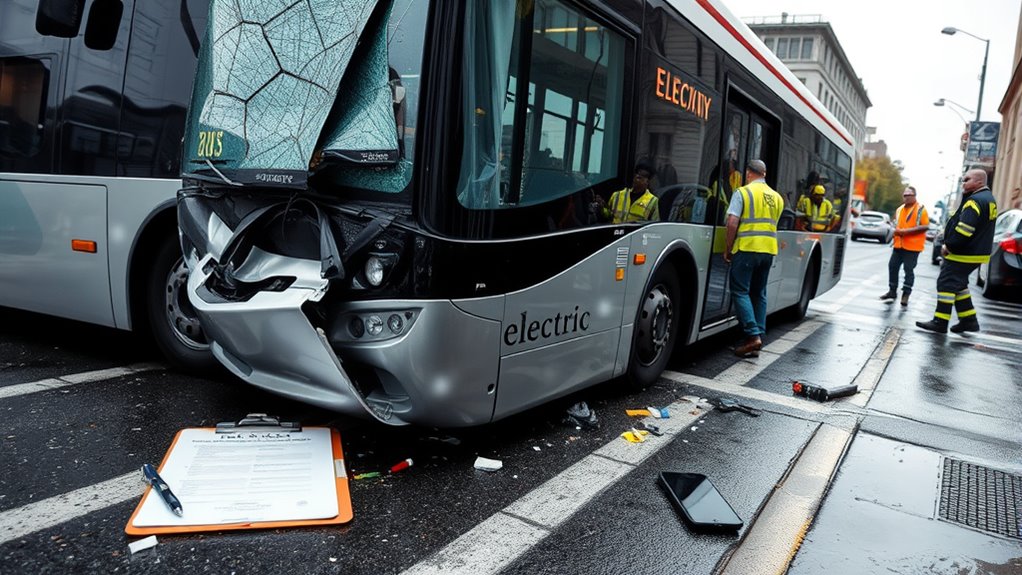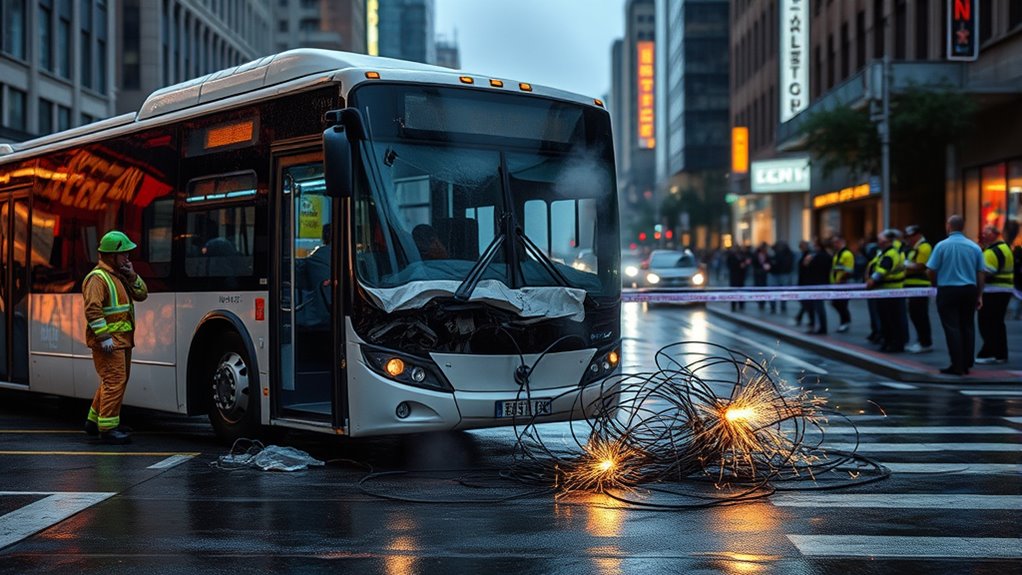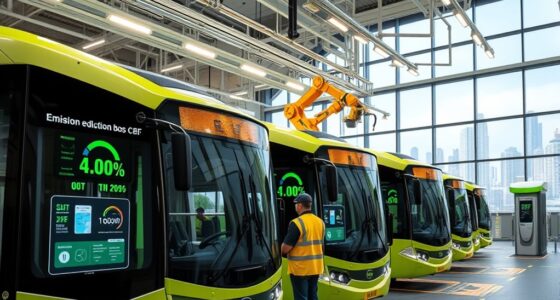When electric bus accidents occur, you face complex legal implications involving multiple parties like manufacturers, drivers, and public agencies. Liability depends on factors such as technological failures, driver error, and infrastructure issues, all governed by evolving safety standards. You need thorough documentation and prompt investigations to establish fault. Understanding these legal nuances can help you better navigate potential claims or liabilities—stay with us to learn more about your rights and responsibilities.
Key Takeaways
- Liability depends on whether the accident resulted from driver negligence, technological failure, or infrastructure issues.
- Public operators may have immunity unless negligence or fault can be proven.
- Proper documentation and investigation are essential to establish fault and damages.
- Multiple parties, including manufacturers and third parties, can share liability in electric bus accidents.
- Evolving safety regulations and standards influence legal responsibility and compliance requirements.

As electric buses become more common in public transportation, understanding their legal implications in case of accidents is essential. Unlike traditional buses, electric models introduce unique challenges and considerations that can impact liability, insurance, and regulatory compliance.
Electric buses in public transit pose unique legal challenges and considerations.
When an accident occurs involving an electric bus, multiple factors come into play, including technological failures, driver error, infrastructure issues, vehicle design limitations, and weather conditions. Recognizing these causes helps you better understand potential legal consequences and how liability might be assigned.
Technological failures, such as electrical faults or battery malfunctions, can lead to loss of control or unexpected stops. If such failures cause an accident, questions arise about whether the manufacturer or maintenance team bears responsibility. Additionally, the integration of complex electronic systems increases the importance of adherence to safety standards, which are continually evolving to address new vehicle technologies.
Driver error remains a significant factor; distracted, inexperienced, or reckless drivers can cause accidents regardless of vehicle type. Although electric buses are generally easier to handle due to their design, driver negligence can still lead to liability claims.
Infrastructure problems, like poorly maintained charging stations or damaged roads, also contribute to accidents and may shift blame toward public agencies responsible for maintenance.
Vehicle design limitations, including visibility issues or blind spots, are inherent risks that can influence accident outcomes. Adverse weather conditions, such as rain or snow, further impair vehicle performance and visibility, adding complexity to legal considerations.
In the aftermath of an accident, determining liability involves examining whether negligence occurred, whether proper safety protocols were followed, and if vehicle defects contributed to the incident. Additionally, the evolving regulatory landscape for electric vehicles influences legal accountability and compliance standards.
The legal framework surrounding electric bus accidents varies depending on whether the operator is public or private. Public operators often benefit from sovereign immunity, which can shield them from liability unless negligence is proven.
Claims against public entities usually require filing within a specified notice period—often six months—and involve strict documentation and procedural requirements.
Private operators, on the other hand, must adhere to state and federal safety standards, carry adequate liability insurance, and follow regulatory compliance protocols to limit their liability exposure.
Liability can extend to multiple parties. Bus drivers may be held accountable if negligent or reckless behavior caused the accident.
Employers can also be liable if they hired unqualified drivers or failed to enforce safety policies.
Manufacturers might face liability if a defect contributed to the crash, while third-party factors, such as external vehicles or environmental conditions, can also play a role.
Often, liability is shared among several parties, complicating legal proceedings. Proper documentation and thorough investigation are crucial in establishing fault and potential damages.
Filing a claim involves notifying the responsible party within the designated period, gathering evidence—such as maintenance records, witness statements, and accident reports—and potentially engaging legal counsel.
The legal process can be lengthy and complex, requiring patience and thorough documentation.
Furthermore, compliance with safety regulations at federal and state levels, including regular inspections and driver training, is crucial in establishing liability and safety standards in electric bus accident cases.
Frequently Asked Questions
Who Is Liable in Electric Bus Accidents Involving Third-Party Vendors?
In electric bus accidents involving third-party vendors, you need to identify who’s responsible. If maintenance or parts supplied by vendors cause the crash, they could be liable.
You should review service contracts, maintenance records, and inspection reports. Also, gather witness statements and physical evidence to support your claim.
Expert opinions on mechanical failures help establish liability. Ultimately, liability depends on whether the vendor’s negligence or defective products contributed to the accident.
How Do Insurance Claims Differ for Electric Versus Traditional Bus Accidents?
When you compare insurance claims for electric and traditional bus accidents, you’ll notice differences in costs and settlement processes. Electric buses often have higher premiums due to their price and technology.
Claims might involve more complex liability assessments because of advanced safety features. Repair costs can also differ, influencing overall claim amounts.
Despite these differences, both types require similar coverage, but electric buses’ tech can lead to unique claims and settlement considerations.
Are There Specific Regulations Governing Electric Bus Safety Standards?
You should know that electric bus safety standards are governed by specific regulations and codes. These include compliance with national standards like NFPA and IFC, federal requirements from the FTA, and local laws.
You’re responsible for ensuring adherence to safety certifications, such as industry best practices, and implementing safety features like automatic disconnects and fire prevention technologies.
Regular maintenance, hazard assessments, and emergency planning are also essential to meet these safety standards.
What Legal Rights Do Passengers Have After an Electric Bus Crash?
You might think you’re powerless after an electric bus crash, but you have legal rights. You can file claims for medical expenses, lost income, and emotional distress if negligence is established.
You also have the right to pursue civil lawsuits or insurance claims against the bus company or responsible parties. Remember, documenting everything and consulting an attorney ensures you fully understand your options to get the compensation you deserve.
How Does Battery Malfunction Impact Liability in Accidents?
When a battery malfunctions during an accident, it directly influences liability. You need to consider if the defect was due to design, manufacturing, or maintenance issues.
If a faulty battery caused the crash, manufacturers could be held responsible under product liability laws. Factors like proper safety features, industry standards, and evidence linking the defect to the accident play a vital role.
Understanding these elements helps determine who’s legally accountable.
Conclusion
When an electric bus accident occurs, you face complex legal implications—liability, insurance claims, and safety regulations. You must steer the legal landscape, understand your responsibilities, and guarantee accountability. You need to assess damages, protect rights, and prevent future incidents. By staying informed, prepared, and proactive, you empower yourself to handle legal challenges confidently, learn from the experience, and contribute to safer transportation. In navigating these legal waters, awareness, responsibility, and action become your best allies.









